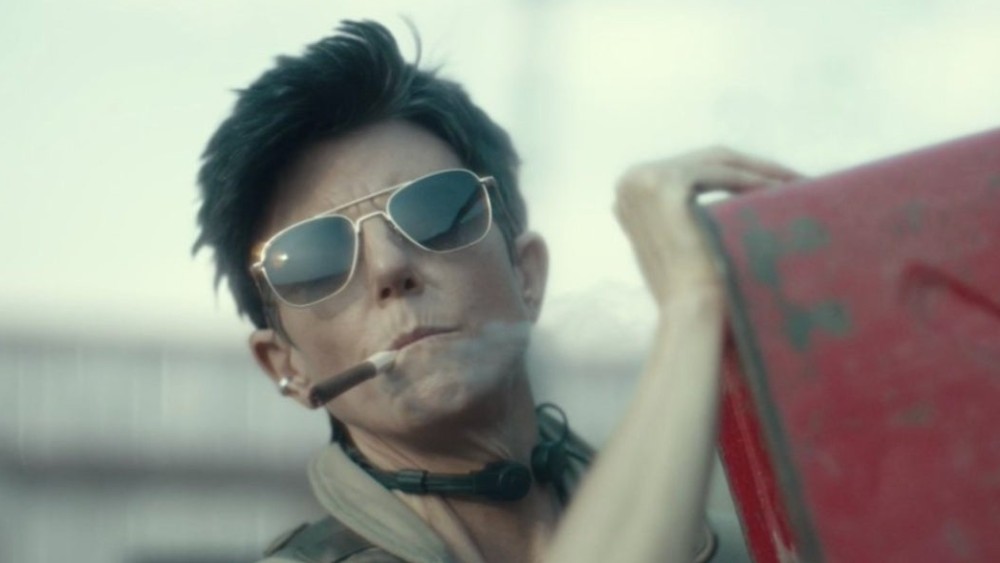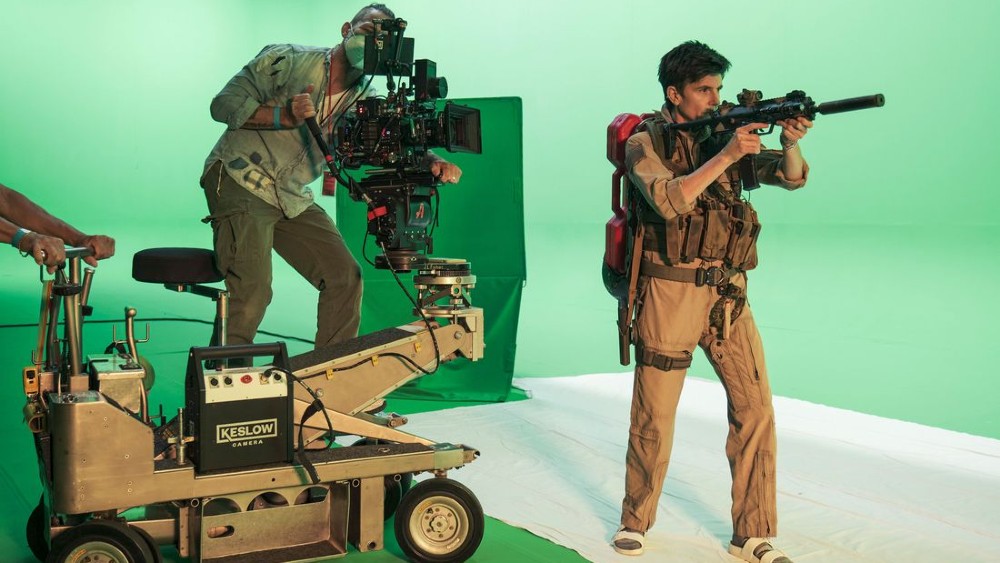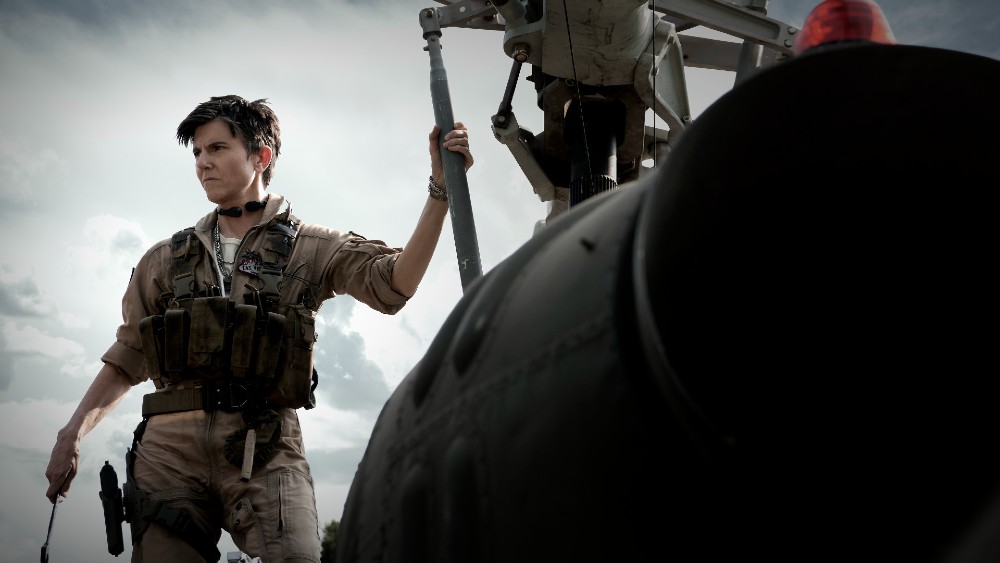
If you read our interview with Army of the Dead VFX Supervisor Marcus Taormina last week, you might remember a brief mention of actor/comedian Tig Notaro being brought in to replace Chris D’Elia, who was canceled in June 2020 due to multiple allegations of sexual improprieties with underage women. Unfortunately, Army of the Dead had finished shooting and was almost finished with its post-production as well, so Director Zack Snyder and his team had to decide what to do.
In this installment of Below the Line‘s quite irregular “Making the Scene” series, we’re back talking to Taormina, as he gave us a rather detailed explanation of what’s involved with inserting a new main character into a big visual FX movie after those VFX are thought to be done.
“What I can tell you is we were very close to finishing the movie when the allegation came up against our actor. I think we were about 20 shots away from visual effects being done,” the VFX Supervisor told us a few weeks back. “It was already at the DI — we were starting to look at color, and we kind of hit pause for a second. We said, ‘Okay, what does this mean?’ At the time, we didn’t know it was gonna be Tig, so we had a really long discussion — just like Zack, Dody [Dorn], our editor, our filmmaking team, Debbie [Snyder] and Wes [Coller], my producer David Robinson — we all kind of sat down and said, “Okay, if we’re gonna do this, we know that the film’s good. It’s tested well. Everyone’s enjoying it. We got to make the movie better. We can’t sacrifice the movie for this.”
“The earliest conversations we had about that was like, ‘We’re not going to lift any scenes, because it just works the way it is. The structure works really well.”’ he continues. “That meant we obviously had to step up to the plate. We don’t want to lift any of those scenes with Peters in them, we just want to make the movie better with Tig. That meant every single scene I had to go through and figure out, ‘Okay, is this a part that is enough where we want to keep Tig in there, or do we do these paint fixes, and just leave it as is?’ I’d say 95% of it was left, and then we obviously had to dive into the complications of the paint fixes. There’s easy paint, and then there were really, really tricky shots with paint.”
It became quite a bit trickier once you realize the size and differences in body shapes between Notaro and the comedian she was replacing. “There’s a very large difference in the 3D space that each actor took up,” Taormina explained. “Chris [D’Elia] is 6′ 2″ and had quite a mass to him, versus Tig, who’s a lot smaller, which meant he was occluding a lot of the actors that he was in front of. I have to say that 99% of it is paint fixes, which was fantastic — they were really complicated paint fixes for some of them. What helped us there is our editorial team, I asked them to pull through all the alternate takes. Even if there were one or two frames that we could see those characters, because the take was slightly different, we would utilize every single frame to do those paint fixes. So then we had kind of our base to lay Tig into, and then the complications of how the lighting was reacting. We just did a full breakdown of the scenes with Tig and asked, ‘Is this an interior or exterior. Are paint fixes happening right now? What kind of light is this, and how do we have to replicate that on stage or in an exterior environment?”
“As we drilled into that, we realized that a lot of these scenes had anchor points to them, so we realized that if we use those anchor points and call them back from storage, we would be able to do a pretty close alignment with camera that would basically make us more efficient,” Taormina says about the next step in the process.
One of those anchor points was when Tanaka reveals the model of the Bly Hotel in his warehouse to plan the Vegas heist that makes up the movie’s main plot. “We based all of those reshoots in that moment, and an interior green screen, but we had the Foamcore model there. We had our little board of stills, and we’d look at the first frame of the cut, and then we’d line up our camera on that, and then we’d walk through the action with Tig, and then we’d mark out the scene with camera marks for Tig, and then we’d do rehearsal. By then, we got pretty good with aligning all the cameras, so the last thing I asked is, ‘Okay, let’s just walk back the camera on that same plane right now, so we have more of Tigg’s performance within frame, so we didn’t have to do a CG Tig bottom because we cut her off too soon. What we had to do is pre-track a lot of our original photography plates, which all the movie is handheld, so we had to account for the handheld portion of it.
Another complication was Snyder’s decision to shoot the film using a super shallow depth of field using “Dream” lenses. “What was great is that by the time we had essentially finished the movie, we learned so much about these lenses. I knew that we didn’t want to shoot any of our elements on them, because that shallow depth of field would not allow us to place Tig in there properly, because essentially, it would be baked in and captured that way. We had to remember that the elements we were shooting may have been further away from us in Z-space that we were allotting for or closer to us. I wanted the best scenario, the crispest element that we could put in there. I had to do some convincing with Zack, and I lost a lot of sleep over it, because I had to check a lot of technical things to make sure that I was on par with it. But that moment when we shot it, and then what we did was we took it and we would mix it on the stage, right on the fly, to verify that it was working. I knew that a sharp element worked, and I knew that in compositing we could soften it, we could color correct it, we could get it to make it look like our Dream lenses, because we knew what those lenses were, what they did. So, in the end again, I think it really is pretty flawless, and we set her in there quite nicely.”

Something that made this plan even trickier was that most of the state of California was shut down in March due to COVID, but they found a two-week window in September to film with Notaro: “It was a unique experience where we had masks on, we had face shields on, Tig would come on set, and we’d have to put down the face shields. Luckily, a lot of it was outside, but there was a reduced crew but a lot of the same crew members we used in our Albuquerque shoot, so our key grip, our AD. Everyone was there on the day, so we could all do that muscle memory of like ‘Oh, yeah, right, we did this camera move like this.’ What we accomplished with Tig in the final movie couldn’t have been accomplished without all those crew members with that experience, throughout.”
“Yeah, the COVID thing was interesting, and I’d say kudos to our whole production because we executed it safely in a very tricky time,” Taormina concludes.
You can still watch how that turned out, because Army of the Dead is still streaming on Netflix.
All photos courtesy of Netflix; Photographer: Scott Garfield.






